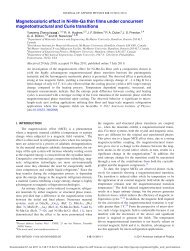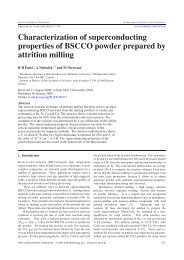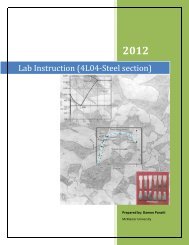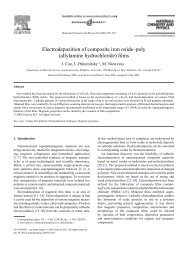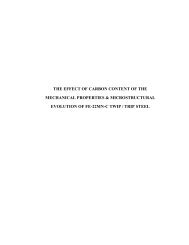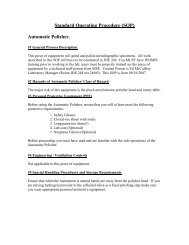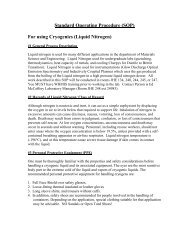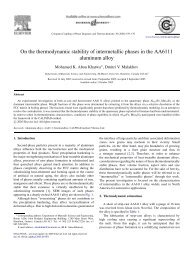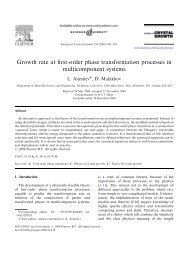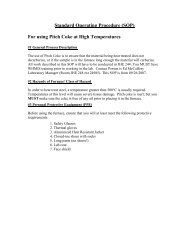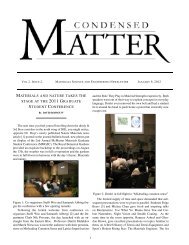E407-07 Microetching Metals and Alloys.pdf - McMaster Department ...
E407-07 Microetching Metals and Alloys.pdf - McMaster Department ...
E407-07 Microetching Metals and Alloys.pdf - McMaster Department ...
You also want an ePaper? Increase the reach of your titles
YUMPU automatically turns print PDFs into web optimized ePapers that Google loves.
TABLE 2 Continued<br />
Etchant Composition Procedure<br />
198 30 mL HF<br />
30 mL HNO 3<br />
30 mL glycerol<br />
199 2 mL HF<br />
5 g AgNO 3<br />
100 mL water<br />
Swab for 60 s. Do not store. Properly discard after use. Solution decomposes on st<strong>and</strong>ing.<br />
Swab for 5 s.<br />
200 A Use a certified <strong>and</strong> tested hood. Immerse in Solution A with gentle agitation for several<br />
seconds. Rinse in Solution B.<br />
40gCrO 3<br />
3gNa 2 SO 4<br />
200 mL water<br />
B<br />
40gCrO 3<br />
200 mL water<br />
201 A Use a certified <strong>and</strong> tested hood. Immerse in Solution A with gentle agitation for several<br />
seconds. Rinse in Solution B.<br />
40gCrO 3<br />
1.5gNa 2 SO 4<br />
200 mL water<br />
B<br />
40gCrO 3<br />
200 mL water<br />
202 A Use a certified <strong>and</strong> tested hood. Immerse in Solution A for 2–5 s. Rinse in Solution B.<br />
10gCrO 3<br />
1gNa 2 SO 4<br />
200 mL water<br />
B<br />
40gCrO 3<br />
200 mL water<br />
203 20 g CrO 3<br />
100 mL water<br />
204 10 mL perchloric acid<br />
10 mL glycerol<br />
70 mL ethanol (95 %)<br />
10 mL water<br />
205 5 mL HF<br />
2 mL AgNO 3 (5 %)<br />
100 mL water<br />
206 5 mL HF<br />
10 mL HNO 3<br />
100 mL glycerol<br />
2<strong>07</strong> 30 mL HNO 3<br />
30 mL acetic acid<br />
30 mL water<br />
208 1 mL NH 4 OH<br />
3 g ammonium persulfate<br />
100 mL water<br />
209 15 mL HNO 3<br />
3mLHF<br />
80 mL water<br />
210 50 mL water (cold) saturated with sodium<br />
thiosulfate<br />
1 g potassium metabisulfite<br />
211 3 g potassium metabisulfite<br />
10 g sodium thiosulfate<br />
100 mL water<br />
<strong>E4<strong>07</strong></strong> − <strong>07</strong> ´1<br />
Copyright by ASTM Int'l (all rights reserved); Thu Sep 20 10:14:59 EDT 2012<br />
20<br />
Downloaded/printed by<br />
MC MASTER UNIVERSITY pursuant to License Agreement. No further reproductions authorized.<br />
Use a certified <strong>and</strong> tested hood. Electrolytic at 0.2 A/cm 2 for 5 s.<br />
Use in a wash down/prechloric rated fume hood. Precaution—Keep cool when mixing <strong>and</strong><br />
use. Electrolytic at 15–50 V for 15–60 s.<br />
Swab vigorously for 10–60 s. Wet cotton frequently.<br />
Precaution—Properly discard after use. Solution decomposes on st<strong>and</strong>ing. Electrolytic at<br />
9–12 V for 1–10 min.<br />
Swab for 5–30 s. Do not store.<br />
Immerse or swab few seconds to a minute.<br />
Immerse 5–60 s.<br />
First ingredient in stock solution. Add potassium metabisulfite before use. Solution good for<br />
several days, or longer. Immerse face up, gently agitate until coloration begins, allow to<br />
settle. Stop etch when surface is red-violet. Etch time varies with material. Colors matrix<br />
phases.<br />
Use fresh solution. Immerse specimen face up, gently agitate solution until coloration<br />
begins, allow to settle. Stop etch when surface is red-violet. Etch time varies with material.<br />
Colors matrix phases.




